Star fruit (Carambola) Nutrition facts
Star fruit, also known as carambola, is a star-shaped tropical fruit with a sweet and sour flavor. Carambola is native to the Malayan peninsula and cultivated in many parts of Southeast Asia, the Pacific Islands, and China for its fruits. Although abundant and plentiful, the carambola has yet to gain popularity, especially in the Western world.
Scientific name: Averrhoa carambola. The genus Averrhoa includes two well-known sorrels (Oxalidaceae) family of fruiting trees, carambola, and bilimbi (tree cucumber).
The fruit is recognized as belimbing manis or balimbing (filipino) in many South-East Asian regions and kamrakh in India.
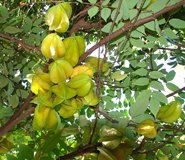
|
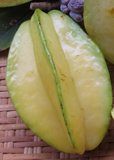
|
| Averrhoa carambola tree with fresh fruits. Photo courtesy: konaboys. |
Starfruit. Photo:scottzona. |
Star fruit is a small, bushy evergreen tree that grows very well under hot, humid, tropical conditions. The plant bears small lilac-colored, bell-shaped flowers in clusters which subsequently develop into oblong-shaped fruits with characteristic five angled edges (sides or ribs) that appear like a starfish in cross-sections.
Both sweet and sour varieties begin to yield under cultivable orchards and are ready for harvesting when the plants reach about 3-4 years old.
Carambola fruit features light-green to yellow with an attractive smooth, waxy surface and weighs about 70-130g. Inside, its crispy and juicy pulp can either be mildly sweet or extremely sour depending upon the cultivar type and amount of oxalic acid concentration. In some seed varieties, 2-5 tiny edible seeds are found at the center./p>
Health benefits of Star fruit
Star fruit is one of the very low-calorie exotic fruits. 100 g fruit just provides 31 calories, which is much lower than for any other popular tropical fruit. Nonetheless, it has an impressive list of essential nutrients, antioxidants, and vitamins required for well-being.
The fruit along with its waxy peel provides a good amount of dietary fiber. Fiber helps prevent the absorption of dietary LDL-cholesterol in the gut. The dietary fibers also help protect the mucous membrane of the colon from exposure to toxic substances by binding to cancer-causing chemicals in the colon.
Star fruit contains good quantities of vitamin-C. Vitamin C is a powerful natural antioxidant. 100 g of fresh fruit provides 34.7 mg or 57% of the daily required levels of vitamin C. In general, the consumption of fruits rich in vitamin C helps the human body develop resistance against infectious agents and scavenge harmful, pro-inflammatory free radicals from the body.
Star fruit is rich in antioxidant phytonutrient polyphenolic flavonoids. Some of the important flavonoids present are quercetin, epicatechin, and gallic acid. The total polyphenol contents (Folin assay) in this fruit is 143 mg/100 g. Altogether, these compounds help protect from the deleterious effects of oxygen-derived free radicals by warding them off the body.
Besides, it is a good source of B-complex vitamins such as folates, riboflavin, and pyridoxine (vitamin B-6). Together, these vitamins help as co-factors for enzymes in metabolism as well as in various synthetic functions inside the body.
It also carries a small amount of minerals and electrolytes like potassium, phosphorus, zinc, and iron. Potassium is an important component of cells and body fluids that helps control heart rate and blood pressure; thus, it counters the bad influences of sodium.
Medicinal uses
Starfruit and its juice are often recommended in many folk medicines in Brazil as a diuretic (to increase urine output), expectorant, and to suppress a cough. (Medical disclaimer).
| Principle | Nutrient Value | Percent of RDA |
|---|---|---|
| Energy | 31 Kcal | 1.5% |
| Carbohydrates | 6.73 g | 5% |
| Protein | 1.04 g | 2% |
| Total Fat | 0.33 g | 1% |
| Cholesterol | 0 mg | 0% |
| Dietary Fiber | 2.80 g | 7% |
| Vitamins | ||
| Folates | 12 µg | 3% |
| Niacin | 0.367 mg | 2.25% |
| Pyridoxine | 0.017 mg | 1.5% |
| Riboflavin | 0.016 mg | 1.25% |
| Thiamin | 0.014 mg | 1% |
| Vitamin A | 61 IU | 2% |
| Vitamin C | 34.4 mg | 57% |
| Vitamin E | 0.15 mg | 1% |
| Vitamin K | 0 µg | 0% |
| Electrolytes | ||
| Sodium | 2 mg | 0% |
| Potassium | 133 mg | 3% |
| Minerals | ||
| Calcium | 3 mg | 0.3% |
| Iron | 0.08 mg | 1% |
| Magnesium | 10 mg | 2% |
| Phosphorus | 12 mg | 2% |
| Zinc | 0.12 mg | 1% |
Selection and Storage
Fresh star fruits can be available twice in a season. In Florida, for example, Arkin cultivars are available from December to March. In general, fruits just short of the ripening stage are picked up for shipment and storage; since the ripe fruits tend to bruise easily, especially at their thin ribbed edges.
While buying, choose uniform, large, attractive-looking, yellow-orange fruits. Avoid green, small-size fruits since they tend to be extremely acidic, and unappetizing. Avoid those with cuts, bruised, shriveled, or spots.
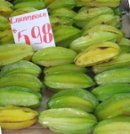
|
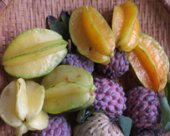 |
| Averrhoa carambola tree with fruits. Photo courtesy: Jorge Brazil. |
Star fruits and custard apples in a market. Photo courtesy:scottzona. |
Ripe fruits tend to perish early. However, they stay well in cold storage when kept at appropriate temperatures. At home, unripe light green fruits may be stored at room temperature until they turn a vibrant orange-yellow color. Ripe fruits may keep well for 2-3 days at room temperature but for extended shelf life, store them in the refrigerator.
Preparation and Serving tips
Star fruits are generally used as a garnish in salads, sorbets, and drinks, as well as to impart tart flavor in dishes.
Given their high oxalic acid content and extreme tartness, they are used quite less frequently in food the industry.
To prepare, wash them thoroughly in cold water, and dry mop using an absorbent cloth. Trim off the ends and edges of the ribbed angles. Cut the fruit crossway into thin sections, which resemble a starfish. Pick out any seeds located near its center.
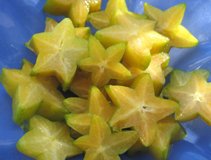
|
| Star fruit sections. Photo courtesy: Cristina's Cards. |
Here are some serving tips:
Only sweet-variety Carambola can be eaten fresh or mixed with other fruits in salads. Fresh fruit can also be juiced and used in cocktails with other complementary tropical fruit juices.
Sour-type fruits are favored in cooking as they impart unique tart flavor to poultry, meat, and seafood dishes.
Cut sections of fresh fruit added to stews, curries, and stir-fries with chicken, and fish and shrimp.
The fruit can be used to make sauce, pickle, chutney, tarts, and jam.
Safety profile
Star fruit is one of the plant sources that contain the highest concentration of oxalic acid; 100 g of fresh fruit contains 50,000-95,800 ppm of oxalic acid.
Oxalic acid has been considered an anti-nutrient compound as it interferes with the absorption and metabolism of several natural minerals such as calcium, magnesium, etc. It also predisposes to a condition known as oxaluria, a condition that may lead to the formation of oxalate kidney stones. In some people with impaired kidney function, its consumption would result in renal failure and may cause death. Individuals with known kidney disease should, therefore, be encouraged to avoid eating star fruit.
Further, Star fruit, like grapefruit, has been found to interact adversely with many drugs. Some of the compounds in the carambola irreversibly inhibit cytochrome P450 3A4 isoenzymes (3A4) in the intestines and liver. This resulting increase in drug levels leads to adverse effects and toxicity. It is, therefore, strongly advised to consult your healthcare practitioner before eating star fruit or its products if taking any pharmaceutical drugs.
(Medical Disclaimer: The information and reference guides in this website are intended solely for the general information of the reader. It is not to be used to diagnose health problems or for treatment purposes. It is not a substitute for medical care provided by a licensed and qualified health professional. Please consult your health care provider for any advice on medications.)
≺≺ Back to Fruits from Star fruit. Visit here for an impressive list of all varieties of fruits with complete illustrations of their nutrition facts and health benefits.
≺≺ Back to Home page.
Further reading and Resources:
USDA National Nutrient Database. (opens in new window)
Stanford School of Medicine Cancer information Page- Nutrition to Reduce Cancer Risk (Link opens in new window).